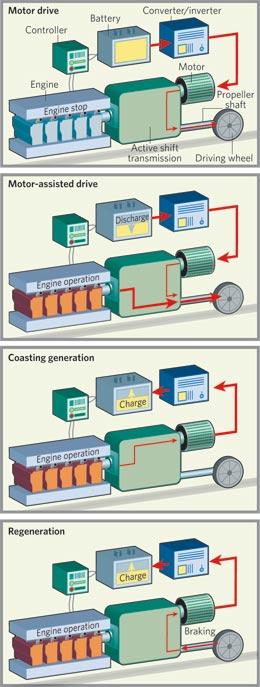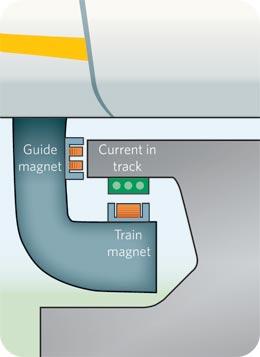Goin' down the road feelin' green
 The heat is on (so to speak) to find alternatives to the internal combustion engine. Concerns over our dependence on foreign oil and the threat of global climate change have fostered renewed and intense interest in thinking about how we transport ourselves from one place to another.
The heat is on (so to speak) to find alternatives to the internal combustion engine. Concerns over our dependence on foreign oil and the threat of global climate change have fostered renewed and intense interest in thinking about how we transport ourselves from one place to another. I've done little to hide my preference for plug-in hybrid electric vehicles, but other alternatives are also being actively pursued including natural gas powered vehicles (the 'Pickens pick') as well as those powered by hydrogen and magnetic rails.
As improbable as it may seem, the era of gasoline-powered transportation dominance could be nearing an end -- or at the very least a serious transition.(GW)
Do the locomotion
In the latest of our Future Transport series, Duncan Graham-Rowe sees trains switching to a greener track.
Running on gas
Several companies are exploring hydrogen fuel cells to power trains. Such 'hydrail' trains are essentially electric but would not need the usual trackside infrastructure. And, unlike diesel trains, fuel-cell-powered trains produce no emissions other than water. Fuel cells produce electric current by combining hydrogen fuel with ambient oxygen using catalytic electrochemical reactions. East Japan Railways has already tested a hybrid fuel-cell train (pictured) on one of its passenger lines and Canada is planning to develop fuel-cell trains in time for the 2010 Winter Olympics in Vancouver.
Europe's first hydrogen-fuelled train is likely to run in Denmark. According to Claus Torbensen, one of the Danish founders of The Hydrogen Train project, such trains could eventually produce zero net emissions. The current problem is that most hydrogen is produced from methane. So although the first fuel-cell trains have to rely on non-sustainable sources of hydrogen, the eventual goal is to power them using hydrogen made through renewable energy, such as by splitting water using wind-turbine-powered electrolysis.
Steaming back to the future
Although it may sound unlikely, a return to steam power could reduce some types of emission. The 5AT Project in Britain aims to prove this by building a new-generation steam engine that overcomes the old drawbacks of steam, and improves on the performance and emissions levels of diesel traction engines. Instead of using coal to generate the steam, these new engines will burn diesel or gasoil (a light type of fuel oil).
Although the steam engines will burn more fuel than diesel engines, and so produce more carbon dioxide, because of the way the fuel is burned, almost all of it will be used up, leaving little unburned. So these new steam locomotives will be virtually smoke free, removing emissions of nitrogen oxides almost entirely. "In this respect 5AT should be cleaner than diesel traction," says Chris Newman, one of the members of the 5AT Project team. Initially, such trains are more likely to be used for tourist lines, to replace existing steam engines. But eventually there is potential for 'new steam' to become competitive with diesel haulage trains, says Newman.
People power
The stations that service the trains also need power, and the East Japan Railway has plans to improve energy efficiency here. It has developed a power-generating floor that uses the vibrations created by commuters walking through the automatic turnstiles to generate electricity. Piezoelectric elements embedded in pads on the floor convert the footfall pressure into electric current. Tests at Tokyo Station showed that the 40,000 or so people who pass over a pad each day can generate 10,000 watt-seconds/day — just enough to light a 100-watt light bulb for 100 seconds. For those who are slightly more demanding of their electricity supply, larger pads will aim to generate enough electricity to power facilities such as information displays and ticket gates.
Making wheels fly
A comeback by the humble flywheel could radically reduce emissions by making trains more fuel-efficient. If a flywheel is geared to the transmission system, the energy lost on braking can be stored as kinetic energy by making the wheel spin. As the train decelerates, the flywheel can accelerate to up to 42,000 revolutions per minute, providing a resistance that also helps slow the train. Similar in principle to the regenerative braking used in electric cars, in this case the energy is stored kinetically, rather than electrically, so less energy is lost as heat. This energy can later be released to help drive the train's wheels or to power an electric motor.
Hybrid hopes
As with cars, electrical energy generated by diesel engines and by regenerative braking can be stored and used to drive electric motors, providing additional power when needed, as when accelerating. The Hokkaido Railway Company in Japan operated the first passenger train using this next-generation diesel–electric hybrid technology. It takes the hybrid concept a step further by storing enough electrical energy so that the diesel engine can be turned off during long stops, which saves energy and reduces noise pollution. When setting off again, the train is driven entirely on the electric motor until it reaches about 45 kilometres per hour, when the diesel is brought online again (see graphic). According to the company, this set-up reduces fuel consumption and emissions by up to 20% compared with conventional diesel–electrics.
RailPower, a Canadian company based in Quebec, has developed a hybrid system that it reckons cuts diesel use by up to 60% and reduces emissions of nitrogen oxides by up to 90%. Its Green Goat trains, which are designed for shunting, use only electric motors to drive the train, with the diesel engines being used to charge the batteries. According to the company, a single Green Goat, carrying out typical railyard operations, will reduce greenhouse-gas emissions by 271 tonnes per year compared with diesel.
Magnetic attraction

The highest-tech solution to driving a train is magnetic levitation, or maglev. This uses a combination of permanent magnets and electromagnets to generate a repulsive force sufficient to lift the train off its supporting rail. At rest, the train is not levitated, but as it begins to move, on wheels, this force increases until there is no longer any contact with the track. The train is propelled by a linear motor that, again using a system of electromagnets built into the track and the train, pushes the train along. The main advantage is that there is no rolling friction, leaving only air resistance and electromagnetic drag to hinder the train. Because of this, maglevs are almost silent at low speeds and can reach cruising speeds of more than 500 kilometres per hour. Maglevs are in operation in China, Japan and Germany, but they are expensive to build because they need an entirely different kind of track. Even so, they produce about a quarter of the emissions of diesel trains, roughly the same as cutting-edge conventional electric trains. And because they are purely electrical, the potential is there to run these trains on entirely renewable energy sources, and so produce zero net emissions.




0 Comments:
Post a Comment
<< Home